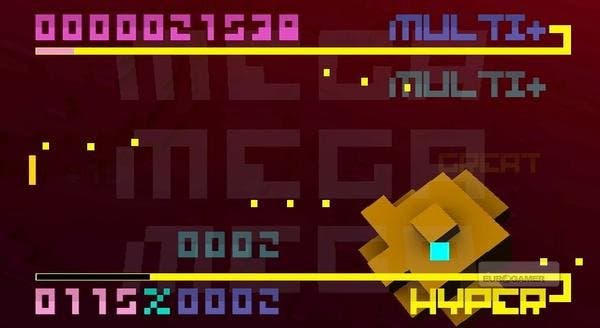Bit. Trip Beat
Dot dot dash.
This temporary retro downgrade acts as player purgatory: manage to refill the top gauge while in this state and the game will be rescued, the level stuttering back to life with colour, sound and spectacle. But fail this challenge and everything grinds to a halt. There is no continuing to be had. Rather, you register your high score, if indeed it's high enough, the only other takeaway being some further solidified memory of the dot patterns that will haunt your sleep.
As with the best arcade games, progress is slow but deliberate: with every attempt you inch forward towards completion, growing further accustomed to the game's immovable patterns and rhythms. While there are only three 'levels' to play through, each one locked until you complete its precursor, they are long and their challenge is tall. By the third song, aptly titled 'Growth', the flurry of dots bounding about the screen will test even the most competent rhythm-action gamer.
In part, that's because the physicality of the control scheme has its own learning curve. You must teach your wrists to twist in smooth, defined movements, snapping backwards and forwards to move the paddle with a sort of precision few Wii games demand. Mainly, however, it's because, unlike Guitar Hero et al, there are no lanes down which the notes travel, no markers to offer a subconscious musical notation of whereabouts on the bar each dot will strike.
Sometimes the dots hang, suspended in air for two bars, before hurtling towards your side of the screen. Other times they simply streak out from nothingness, the challenge then one of reaction and revision rather than rhythm-action's usual discipline of learning to read primary colour sheet music. To help you discern which dot does what, their pixels are colour-coded by behaviour. Orange dots move in a flat horizontal line; yellow dots bounce off walls testing your reading of diagonals; purple dots move as a sine wave while pink dots spin in a clockwise or counter-clockwise direction. Sometimes you'll be sent a single white cluster of pixels to rebuff, a challenge trigger that reduces your paddle to a mere blip, amplifying the need for precision, exaggerating the stress of the situation.

This skewed focus makes Bit Trip Beat different to its music game contemporaries, the skills it tests closer to those required in reading Rez's bullet patterns than interpreting Dance Dance Revolution's arrow streams. This looser relationship between music and play offers, then, an alternate experience to that found elsewhere. But towards the end of the game, developer Gaijin Games is clearly struggling to increase the difficulty in ways other than just hurling fistfuls of dots at the player. Here new dots are introduced, trailing long tails across the screen as they travel, making unreasonable demands of the player by obscuring the screen with their flair.
For that reason, the game's brevity is a positive, ensuring Bit Trip Beat burns brightly without having to grind on after it's extinguished its best ideas. The result is a brisk, radiant creation, presenting a nostalgic celebration of the medium's beginnings as well as a bold testament to how those narrow compulsions that inspired people to play videogames thirty years ago are, in fact, timeless.

